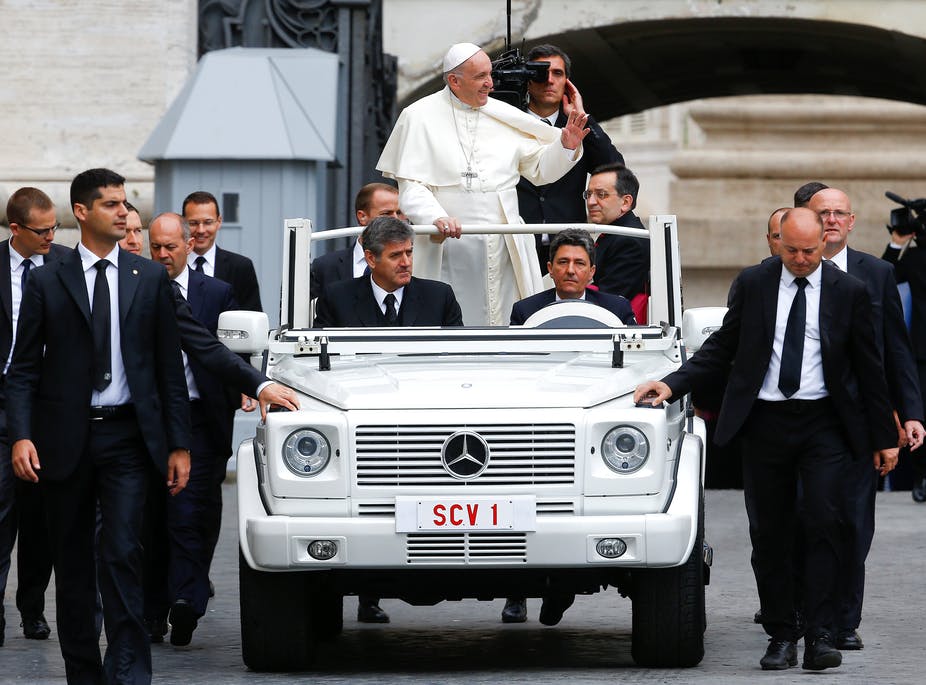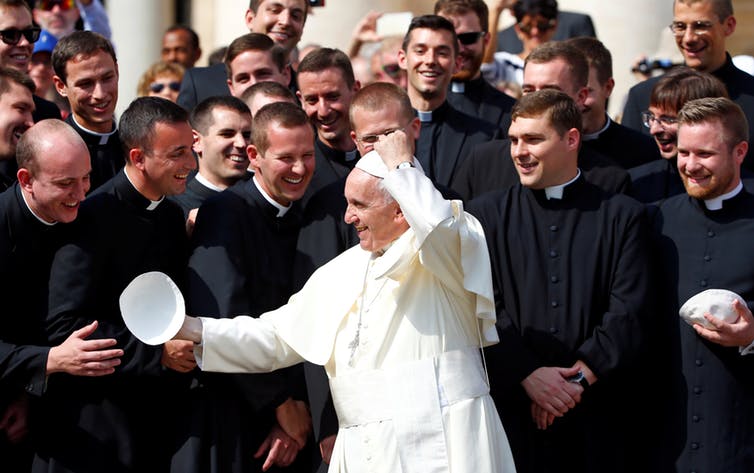Why the Catholic church is ‘hemorrhaging’ priests
Verónica
Giménez Béliveau, The Conversation, May 25, 2018
Priests
are Catholicism’s greatest figures: shepherds who manage believers’
relationship with the divine.
are Catholicism’s greatest figures: shepherds who manage believers’
relationship with the divine.
 |
| Pope Francis has acknowledged that celibacy is one of the challenges of the Catholic Church in the 21st century. Reuters/Stefano Rellandini |
But, as Pope Francis
recently acknolwedged, their numbers are dwindling. In fact, the
number of priests worldwide has been dropping since the 1930s.
In
Argentina, a predominantly Catholic country, the Church lost 23 percent of
its priests and nuns from 1960 to 2013. France
and Spain
have also seen a dramatic reduction in clergy. Across Europe, the number of
priests declined
almost 4 percent between 2012 and 2015 alone.
Argentina, a predominantly Catholic country, the Church lost 23 percent of
its priests and nuns from 1960 to 2013. France
and Spain
have also seen a dramatic reduction in clergy. Across Europe, the number of
priests declined
almost 4 percent between 2012 and 2015 alone.
Why is
the church “hemorrhaging” priests, to use Pope Francis’s words? I study Catholic
history, so I have long considered this question.
the church “hemorrhaging” priests, to use Pope Francis’s words? I study Catholic
history, so I have long considered this question.
Why are
there fewer priests?
there fewer priests?
The
demands of the job are a killer combination in today’s world.
demands of the job are a killer combination in today’s world.
Between
strict restrictions on sexuality and the loss of priests’ social status, there
are ever fewer seminary students. Consequently, fewer men become priests,
particularly in remote parts of the world. In the Amazon
region, there is one priest for every 10,000 Catholics.
strict restrictions on sexuality and the loss of priests’ social status, there
are ever fewer seminary students. Consequently, fewer men become priests,
particularly in remote parts of the world. In the Amazon
region, there is one priest for every 10,000 Catholics.
Responding
to this challenge, Pope Francis in 2017 suggested that the Church might allow married
men to be ordained. Many Church
officials believe the requirement of celibacy is the main reason
fewer men are joining the priesthood.
to this challenge, Pope Francis in 2017 suggested that the Church might allow married
men to be ordained. Many Church
officials believe the requirement of celibacy is the main reason
fewer men are joining the priesthood.
The
pope’s statements are not aimed at undoing an historic pillar of the sacred
institution of the priesthood.
pope’s statements are not aimed at undoing an historic pillar of the sacred
institution of the priesthood.
Rather,
Pope Francis has simply suggested that the Church consider some exceptions.
Among other changes, the pontiff has indicated that married Catholic men could
assume certain church duties in far-flung regions, invoking the figure of the
“viri probati” – or men of unquestionable faith, virtue and obedience.
Pope Francis has simply suggested that the Church consider some exceptions.
Among other changes, the pontiff has indicated that married Catholic men could
assume certain church duties in far-flung regions, invoking the figure of the
“viri probati” – or men of unquestionable faith, virtue and obedience.
 |
| The decline in the number of new priests is particularly acute in remote areas of the world. Remo Casilli/Reuters |
More men
of the cloth
of the cloth
In other
words, the pope has suggested filling the gaps in the priesthood with something
markedly similar to an existing institution, the diaconate.
words, the pope has suggested filling the gaps in the priesthood with something
markedly similar to an existing institution, the diaconate.
Also
known as “deacons,” these men complete a two- to four-year course and are
ordained to assist priests and bishops. They can baptize, marry, preach and
administer the Eucharist, but they cannot take confession.
known as “deacons,” these men complete a two- to four-year course and are
ordained to assist priests and bishops. They can baptize, marry, preach and
administer the Eucharist, but they cannot take confession.
Though
the concept is as old as Christianity itself – the Church traces it to
the apostles – the diaconate has garnered renewed interest in recent
years as priests have become scarce.
the concept is as old as Christianity itself – the Church traces it to
the apostles – the diaconate has garnered renewed interest in recent
years as priests have become scarce.
Invite
women into the ministry
women into the ministry
Deacons
don’t have to remain chaste. However, like the priesthood, this ministry does
not allow women.
don’t have to remain chaste. However, like the priesthood, this ministry does
not allow women.
So, in
August 2016, at the request of the Synod of Bishops, the highest Catholic
decision-making body, Pope Francis established a commission
to study female deacons. Ordained female deacons supporting an
all-male ministry would not entirely fulfill progressive Catholics’ demands to allow women in the priesthood, but it has
calmed some anxiety and indicated a potential path forward.
August 2016, at the request of the Synod of Bishops, the highest Catholic
decision-making body, Pope Francis established a commission
to study female deacons. Ordained female deacons supporting an
all-male ministry would not entirely fulfill progressive Catholics’ demands to allow women in the priesthood, but it has
calmed some anxiety and indicated a potential path forward.
It might
also ease some of the priesthood’s staffing shortages.
also ease some of the priesthood’s staffing shortages.


